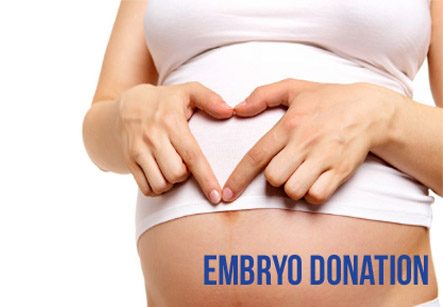Embryo Donation
Introduction
Today’s age, women are career oriented. By the time they get married and start planning to have children, they are nearing the fourth decade of their life (40 years). Fortunately, at this age, many women can conceive naturally. However, nearly 10 to 15% women fail to conceive within a year’s time. These women who are more than 37-40 years of age then route to treatment of infertility by their gynaecologists. If they still do not become pregnant they take help of newer technologies like IVF or ICSI – Intra Cytoplasmic Sperm Injection.
Women after the age of 40 tend to have fewer eggs in their ovaries or the quality of the eggs they produce may be poor. Thus, even new technologies like IVF and ICSI may not ensure a successful pregnancy. Furthermore, after the age of 40 to 42, many women stop producing eggs as they enter the stage of Perimenopause (decreased periods) or menopause (stoppage of periods). Till now, such women could only have a baby through the wonderful route of adoption. However, in the last ten years, a new technique of egg donation has come as a blessing to many such women.
Embryo donation has found to be approximately twice as cost-effective as egg donation in terms of cost per live birth, as proven in research studies. Iran ranks first in the region in terms of infertility treatment studies

Embryo donation is a type of third party reproduction. It is defined as the giving (mostly without compensation) of embryos, remaining after one couple’s IVF (in vitro fertilization) treatment, to another couple, followed by the placement of those embryos into the recipient woman’s uterus to facilitate pregnancy and childbirth in the recipient.
The embryos are donated after the woman, for whom they were originally created, has successfully carried one or more pregnancies to term. The resulting baby is considered the child of the woman who carries embryo and gives birth to the baby. In principle, an embryo donation is as same as that of egg or sperm donation.
Embryo donation has found to be approximately twice as cost-effective as egg donation in terms of cost per live birth, as proven in research studies.
There are various ways in which embryo donation takes place.
1. On an anonymous basis- where the donor and the recipient do not know each other
2. On an open basis- where identities are shared mutually and the families agree to a relationship.
3. On a semi-open basis- in which the parties mutually know the families and other information about each other, but their real identities and locating information are withheld, in order to maintain privacy protection.
Sometimes, the term embryo donation is used to refer strictly to anonymous embryo donation, whereas embryo adoption refers to the open process.
Screening:
• In many nations, donated embryos generally get screened multiple times for infectious diseases. U.S. Food and Drug Administration (FDA) has charted the rules of screening of such embryos.
• In case of donor not being available for screening, the donated embryos are labeled as “to be screened”, so later the recipients must agree to accept the associated risk.
Other alternatives:
Remaining embryos may have any fate, as described below:
• They may be implanted at a time when pregnancy is unlikely to take place
• They may be employed embryonic stem cell research.
• They may be discarded, although embryos can, theoretically, survive indefinitely in frozen storage.
Process:
Embryo donation can be carried out
• By any of several national organizations or
• As a service of an individual infertility clinic, where donor and recipient families live in the local area and are both patients of the same clinic
The process illustrated here is characteristic of an “adoption-agency-based” case:
1. Biological parents entering an embryo adoption program are offered the benefits of selecting the adoptive parents from the agency’s pool of pre-screened candidates.
2. Embryo ownership is reassigned directly from the biological parents to the adoptive parents.
3. Biological parents may be updated by the agency when a successful pregnancy is achieved and when a child(ren) is/are born.
4. The biological parents and adoptive parents may negotiate their own terms for future contact between the families.
5. Prospective adoptive parents entering a program complete an application, adoption education, and health checks and in some cases, depending on the requirements of both the home study and placement agencies, court certification of adoption eligibility.
6. Their completed paperwork and fees are submitted to the placement agency, which reviews their files and matches them to genetic parents with similar preferences including desired level of openness post-adoption.
7. Biological and adoptive parents are then given the chance to approve the match.
8. Once all parties agree, the embryo is transferred to the adoptive mother’s clinic for a frozen embryo transfer